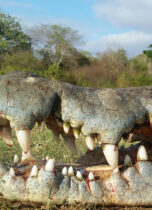
A crocodile can be added to your big game safari for a trophy fee, or booked in combination with a hippo hunt. These croc and hippo hunts take place in remote areas and at least 10 days is advised. Crocodile are a challenging animal to hunt. They can smell as good as an antelope, see relatively well, feel vibrations in the water and on the ground, and I believe that they effectively use the shore birds calls to alert them of approaching danger. The trick to crocodile hunting is to locate a big croc on the shore sun bathing. Then set up a blind or sneak up to a shooting position. One mistake and the animal will retreat to the water. The best way to secure your trophy is by a shot in the neck. Many professional hunters advise a head shot when hunting crocodile, I disagree. A shot in the neck is more successful at anchoring the animal on the bank and provides the hunter with a bigger target. One flick of their powerful tail from a slightly off brain shot will send him sliding down the bank into the water. They do not float and it’s a bad idea to go swimming to locate the carcass! A dead rest will be used for the shot and it is typically at a distance of less than 75 yards.
These animals can be over 100 years old and risky shots are not allowed. It is a privilege to be able to hunt such a prehistoric animal. Crocodile are CITIES II animals and hunted trophies are allowed to be imported into the USA.
General Crocodile Information
- Size: up to 20 ft., very rare average size of a mature male 13 – 15 ft.
Weight: up to 2,000 lbs.
Average life span in the wild: up to 100 years- The Nile crocodile has a somewhat deserved reputation as a vicious man-eater. The proximity of much of its habitat to people means run-ins are frequent. And it’s virtually indiscriminate diet means a villager washing clothes by a riverbank might look just as tasty as a migrating wildebeest. Firm numbers are sketchy, but official estimates are that up to 200 people may die each year in the jaws of a Nile croc. I believe the number to be much higher.
- Nostrils, eyes, and ears are situated on the tops of their head, so the rest of the body can remain concealed underwater. Their coloration also helps them hide: Juveniles are grey, dark olive, or brown; with darker cross-bands on their tail and body. As they mature they become darker and the cross-bands fade, especially those on the body. The underbelly is yellowish, and makes high-quality leather.
- They normally crawl along on their bellies, but they can also “high walk” with their trunks raised above the ground. Smaller specimens can gallop, and even larger crocodiles are capable of surprising bursts of speeds, briefly reaching up to 12 to 14 km/h (7.5 to 8.5 mi/h). They can swim much faster by moving their body and tail in a sinuous fashion, and they can sustain this form of movement much longer at about 30 to 35 km/h.
- They have a four-chambered heart, like a bird, which is especially efficient at oxygenating their blood. They normally dive for only a couple of minutes, but will stay underwater for up to 30 minutes if threatened, and if they remain inactive they can hold their breath for up to 2 hours. They have an ectothermic metabolism, so they can survive a long time between meals. When they do eat they can eat up to half their body weight at a time.Their jaws are capable of exerting impressive force as they hold on to their prey. Their mouths are filled with a total of 64 to 68 cone-shaped teeth. Nile crocodiles in captivity have lived up to 56 years, but scientists estimate that in their natural habitat, they can live 70–100 years.
- The Nile crocodile is the largest African crocodilian and the second largest crocodilian after the Saltwater crocodile, reaching lengths of up to 5 m (16 ft.), or rarely up to 6.1 m (20 ft.).[1] Good sized males weigh 500 kg (1100 lb.), and truly exceptional specimens may exceed 900 kg (2,000 lb.). Like all crocodiles they are sexually dimorphic, with the males up to 30% larger than the females, though the difference is even less in some species, like the saltwater crocodile.
- Seven meters (23 ft.) and larger specimens have been reported, but since gross overestimation of size is common these reports are suspect. The largest living specimen is purported to be a notorious man-eater from Burundi named Gustave; he is believed to be approximately 20-30 feet long. Such giants are rare today.
- One unusual characteristic of this fearsome predator is its caring nature as a parent. Where most reptiles lay their eggs and move on, mother and father Nile crocs ferociously guard their nests until the eggs hatch, and they will often roll the eggs gently in their mouths to help hatching babies emerge.
















